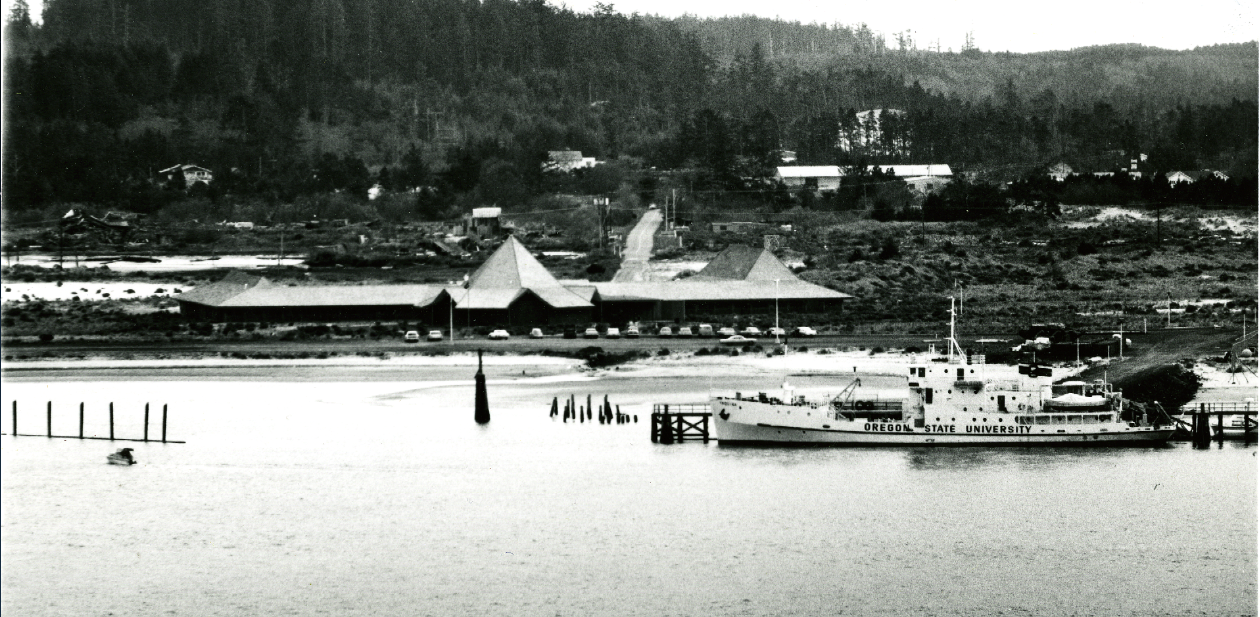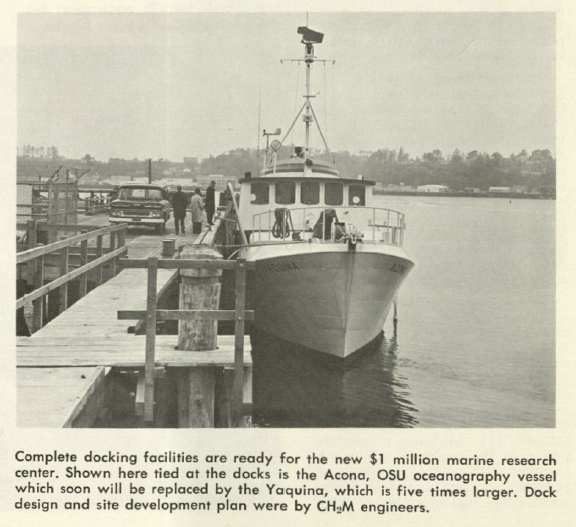
Yaquina Bay and Early OSU Marine Science Center with Research Vessel "Yaquina", Circa 1970
A true history of marine research in Newport must extend back decades before the roots of HMSC took hold. In 1939, Roland Dimick, head of the OSU Department of Fisheries & Wildlife, established the Yaquina Bay Fisheries Laboratory at Sally’s Bend, on the opposite side of the bay from the current HMSC. This facility operated until 1965, when three circumstances came together to set in motion the construction of the Marine Science Center (not yet named after Senator Mark Hatfield). First, Dimick needed more space for the fisheries lab. Second, Dr. Wayne Burt had founded the OSU Department of Oceanography, and needed a place for research vessels to call home. And finally, in the wake of the decline of fishing and logging, the small town of Newport needed an economic shot in the arm.

The answer to all of these needs arrived in the form of an infusion of cash from the federal Area Redevelopment Administration. The Port of Newport granted OSU a 99-year lease on 49 acres of the old Yaquina Bay ferry dock. OSU agreed to run the facility, which included a public aquarium focused on increasing tourism.
The new lab was opened to much fanfare in June 1965. Early research topics included oyster culture techniques, effects of pesticides on estuary animals, rocky shore ecology, and parasitology.
The Center bustled with research activity, but the cohesive, collaborative atmosphere that drives HMSC today had yet to blossom. While multiple OSU programs were represented, they did not yet collaborate. With Fisheries and Wildlife personnel located in the west wing of the center, and Oceanography and other departments working in the east wing, a feeling of unity had not yet developed. In addition, research was hampered by a deficient seawater distribution system and a paucity of operating funds.
This atmosphere changed thanks to the leadership of two men: John Byrne and Lavern Weber. Byrne served as the first Chair of the OSU Oceanography Department, and was named director of the overall Marine Science Center in 1972. Weber, the first resident director of the Center, began his long tenure in 1977. Weber, in particular, brought the center together under central leadership and cultivated an atmosphere of conviviality and cooperation. He fought for enhanced funding for research and education programs, and also spearheaded an immense new project: installing a seawater pumping and storage system. Much of the current research activity at HMSC is possible because of this facility.
 Education was always a part of the Center’s mission, but the approach has changed over time. At first, there was no dedicated Visitor Center staff; educational duties fell to Center faculty. But 50,000 people visited the Center in the first year, and Center scientists were quickly overwhelmed by the public’s interest. This demand helped push OSU to develop its marine extension and education program, which led to its becoming one of the first four colleges in the nation to be designated a Sea Grant institution. The successful marine advisory program, Extension/Sea Grant, was brought to HMSC by Bill Wick, the first director of Oregon Sea Grant.
Education was always a part of the Center’s mission, but the approach has changed over time. At first, there was no dedicated Visitor Center staff; educational duties fell to Center faculty. But 50,000 people visited the Center in the first year, and Center scientists were quickly overwhelmed by the public’s interest. This demand helped push OSU to develop its marine extension and education program, which led to its becoming one of the first four colleges in the nation to be designated a Sea Grant institution. The successful marine advisory program, Extension/Sea Grant, was brought to HMSC by Bill Wick, the first director of Oregon Sea Grant.
The Oregon Department of Fish & Wildlife has been a presence here for decades, having built their facility on campus in 1970, but some of the other strong agency-OSU relationships began more recently. Critical milestones in the early history of the Center include the arrival of EPA (1980) and NOAA (1981) research programs. In 1983, to acknowledge his long-time support, the Center was named after Oregon Senator Mark O. Hatfield. Under its new name, HMSC saw the establishment of the Coastal Oregon Marine Experiment Station (1989), the construction of the USFWS building (1990) and the Guin Library (1991). The newly expanded and renovated Visitor Center was completed and dedicated in 1997, and NOAA’s Barry Fisher building, the most recent addition to campus, was completed in 2003.
After Lavern Weber’s retirement, George Boehlert took the helm as Director, continuing on the path of supporting collaborative research and outstanding education programs. Major milestones reached during his tenure include the establishment of the Marine Mammal Institute and the Free Choice Learning program, and the development of the Research Experience for Undergraduates summer internship program. The foundation for the Marine Studies Initiative was also laid under Boehlert’s leadership. He worked extensively with local organizations to emphasize a connection between the economic growth of the community and the scientific and educational goals of HMSC. His work with the community contributed to the strategy behind the Port of Newport’s successful bid for the NOAA Marine Operations Center - Pacific facility.
Images Courtesy of Special Collections Archives Research Center (SCARC)